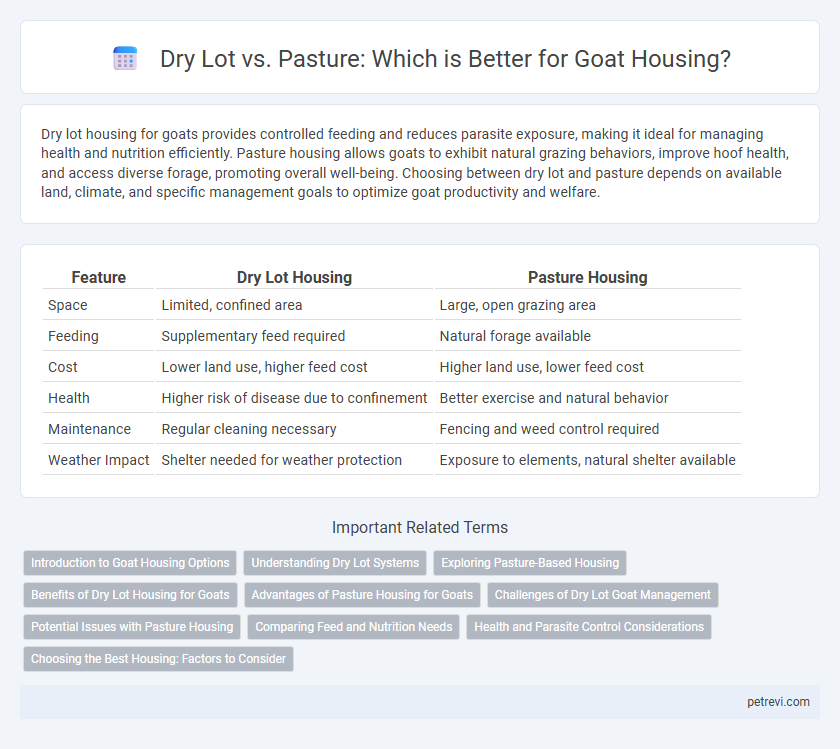Dry lot housing for goats provides controlled feeding and reduces parasite exposure, making it ideal for managing health and nutrition efficiently. Pasture housing allows goats to exhibit natural grazing behaviors, improve hoof health, and access diverse forage, promoting overall well-being. Choosing between dry lot and pasture depends on available land, climate, and specific management goals to optimize goat productivity and welfare.
Table of Comparison
| Feature | Dry Lot Housing | Pasture Housing |
|---|---|---|
| Space | Limited, confined area | Large, open grazing area |
| Feeding | Supplementary feed required | Natural forage available |
| Cost | Lower land use, higher feed cost | Higher land use, lower feed cost |
| Health | Higher risk of disease due to confinement | Better exercise and natural behavior |
| Maintenance | Regular cleaning necessary | Fencing and weed control required |
| Weather Impact | Shelter needed for weather protection | Exposure to elements, natural shelter available |
Introduction to Goat Housing Options
Dry lots provide a controlled environment with minimal mud and parasites, ideal for managing goat hygiene and hoof health. Pastures offer natural forage and encourage grazing behavior, which supports digestive health and reduces feed costs. Proper selection between dry lots and pasture depends on climate, soil quality, and the specific needs of the goat breed.
Understanding Dry Lot Systems
Dry lot systems for goat housing offer controlled environments with limited vegetation, reducing parasite exposure and minimizing soil erosion compared to pasture systems. They enable precise feeding management, improving nutrient intake and overall health by preventing overgrazing and allowing targeted supplementation. Properly designed dry lots with adequate drainage and shelter promote goat comfort and productivity year-round.
Exploring Pasture-Based Housing
Pasture-based housing for goats offers natural forage that enhances diet diversity and promotes better rumen health compared to dry lot systems. Access to pasture enables goats to exhibit natural grazing behaviors, improving overall welfare and reducing stress levels. Properly managed pasture can also minimize parasite load and improve soil fertility through natural manure distribution.
Benefits of Dry Lot Housing for Goats
Dry lot housing for goats offers improved control over feeding and nutrition, reducing parasite exposure often found in pasture environments. This method enhances hoof health by preventing constant moisture contact associated with pasture grazing, minimizing the risk of foot rot. Additionally, dry lots facilitate easier manure management and sanitation, contributing to overall herd health and productivity.
Advantages of Pasture Housing for Goats
Pasture housing for goats offers abundant natural forage, enhancing their nutrition and promoting healthier growth. This environment allows goats to exhibit natural behaviors like grazing and browsing, which improve their overall well-being and reduce stress. Access to pasture also increases exercise opportunities, leading to stronger muscles and improved immune system function.
Challenges of Dry Lot Goat Management
Dry lot goat management presents challenges such as maintaining adequate forage nutrition and preventing soil degradation due to concentrated animal activity. Goats in dry lots require carefully managed supplemental feeding strategies to meet their dietary needs and avoid weight loss or malnutrition. Soil compaction and manure buildup necessitate regular cleaning and rotation practices to reduce parasite loads and promote animal health.
Potential Issues with Pasture Housing
Pasture housing for goats can lead to overgrazing, soil erosion, and parasite infestations due to constant exposure to contaminated ground. Goats are prone to internal parasites such as Haemonchus contortus, which thrive in moist pasture conditions, increasing health risks. In contrast, dry lot housing reduces these risks by providing better waste management and minimizing direct contact with contaminated soil.
Comparing Feed and Nutrition Needs
Dry lot housing for goats concentrates on controlled feeding with stored hay and grain, providing precise nutrient management and minimizing forage variability. Pasture-based systems offer goats access to diverse forage species, promoting natural grazing behavior and often enhancing fiber and mineral intake. Balancing feed quality and nutrient availability is crucial in both systems to support optimal goat growth, reproduction, and overall health.
Health and Parasite Control Considerations
Dry lot housing for goats reduces exposure to parasites commonly found in pasture environments by limiting contact with contaminated soil and vegetation. Pasture grazing offers natural forage but increases the risk of internal parasite infestations such as Haemonchus contortus, necessitating regular fecal egg counts and rotational grazing practices. Effective parasite control hinges on balancing environmental cleanliness in dry lots with strategic pasture management to maintain goat health and minimize anthelmintic resistance.
Choosing the Best Housing: Factors to Consider
Dry lot housing for goats provides controlled feeding and easier manure management, reducing parasite exposure and improving herd health. Pasture housing allows goats to graze naturally, promoting exercise and access to diverse forage, which supports digestive health and natural behaviors. Choosing the best housing depends on factors such as land availability, climate, parasite control, and the goats' nutritional needs to ensure optimal welfare and productivity.
Dry lot vs Pasture for Goat housing Infographic

 petrevi.com
petrevi.com